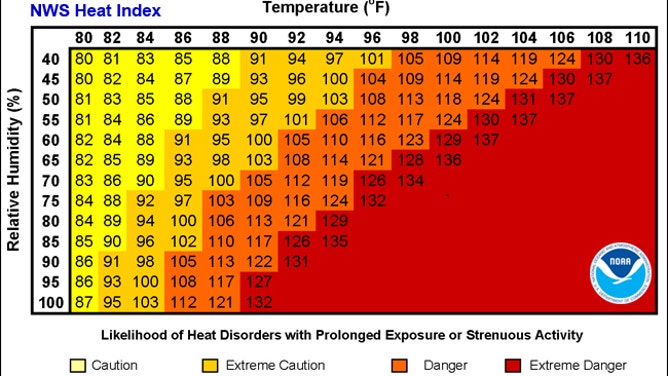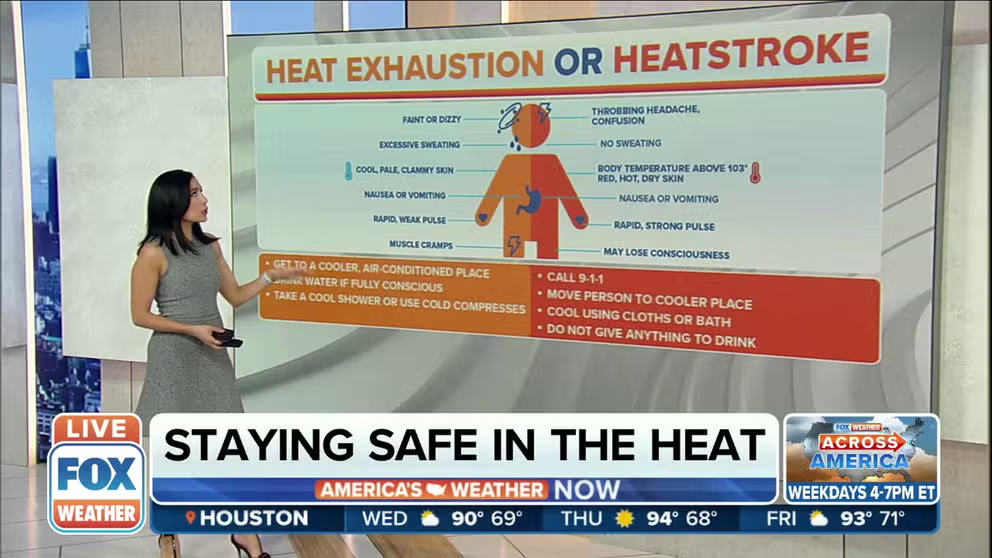What is the heat index and why is it important to your health?
The heat index is essentially the 'feels-like' temperature
Heat exhaustion vs. heatstroke—What to know
FOX Weather’s Marissa Torres breaks down the two heat-related illnesses.
A typical summertime forecast shows both a high temperature and a heat index for the day, but you might not understand the significance of the heat index on a hot and humid afternoon.
The heat index is a measure of how hot the air feels when taking into account the combination of the air temperature and the relative humidity or dew point. In other words, the heat index is the "feels-like" temperature.
HOW TO WATCH FOX WEATHER ON TV
The National Weather Service developed the chart below to easily determine the heat index. Simply match the air temperature on the horizontal axis at the top with the relative humidity on the vertical axis along the left-hand side, find where the two values intersect, and that number is your heat index.

The National Weather Service heat index chart.
(National Weather Service)
There is also a heat index calculator available on this NWS webpage if you prefer to use the dew point instead of relative humidity for the heat index calculation.
WHY DEW POINT IS THE BEST WAY TO CLASSIFY HOW MUCH HUMIDITY IS IN THE AIR
On a humid day in the summer, the heat index will be notably higher than the actual air temperature.
The FOX Weather app might predict a high temperature of 88 degrees – the average high in Philadelphia for much of July – but if the relative humidity is 60% or the dew point is 72 degrees, the heat index will peak at 95 degrees that day. Most people would likely agree that a 95-degree afternoon is much more uncomfortable than an 88-degree afternoon.
The NWS also developed the heat index chart below for areas that experience hot temperatures but with low relative humidity, such as the Desert Southwest.

The National Weather Service heat index chart.
(National Weather Service)
These heat index values were formulated for shady, light-wind conditions, but you should be aware that exposure to full sunshine can increase the "feels-like" temperature by as much as 15 degrees, according to the NWS.
HOW TO TELL THE DIFFERENCE BETWEEN HEAT EXHAUSTION AND HEATSTROKE
The red areas on both charts indicate extreme danger, meaning there’s a serious risk of heatstroke if you spend any significant amount of time outdoors in those conditions. The orange areas indicate danger, with muscle cramps and/or heat exhaustion likely if outdoors for too long; heatstroke is also possible with prolonged exposure and/or physical activity such as running or biking.
The more humidity in the air, the more difficult it is for your body to stay cool because there is less evaporation of the perspiration from your skin. Evaporation is a cooling process, so the evaporation of that sweat is your body’s natural way of cooling itself down. More evaporation occurs when the air is dry than when it’s humid, so it is easier to cool down in a "dry heat."
CLICK HERE TO GET THE FOX WEATHER UPDATE PODCAST
When high heat indices are expected, the NWS issues Excessive Heat Watches, Excessive Heat Warnings and Heat Advisories to warn the public of the dangerous conditions. The criteria for these heat alerts vary across the United States and are based upon the local climate of a region, but in general, one or more of those alerts will be posted if the heat index is predicted to reach 100 degrees or higher.
